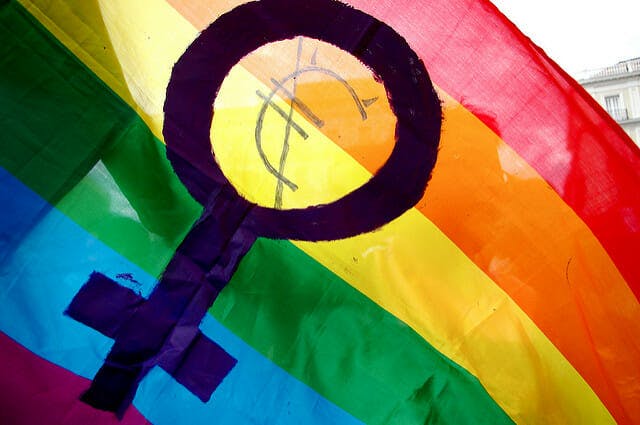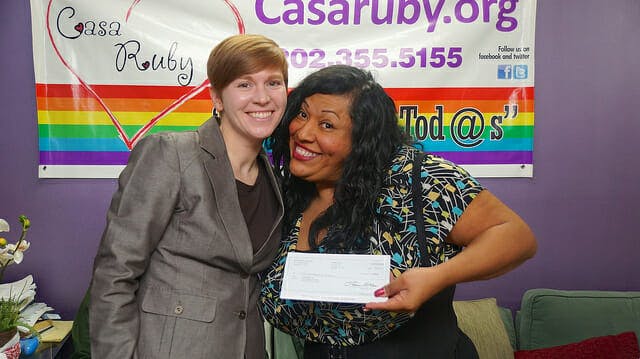Cisgender people have one of the most common identities in the world—but most cis people don’t even realize they’re cis. In recent years, the term has been used in conjunction with transgender rights as a parallel to transgender men, women, and non-binary individuals’ experiences, highlighting the privileges that cis people experience in relation to transphobia and transmisogyny.
But for most people, “cis” and “cisgender” are strange, new concepts. Even LGBTQ activists are still learning a lot about being cis. What does it mean to be cisgender, and what exactly is “cisgender privilege?” Here’s everything you should know.
What is cisgender?

The term “cisgender” has become more prominent in the past couple of years. Major dictionaries now include the term; Merriam-Webster describes cisgender as “of, relating to, or being a person whose gender identity corresponds with the sex the person had or was identified as having at birth.”
In short, any person who identifies with their sex and gender assigned at birth is cisgender. A cisgender man, for example, is a person assigned male at birth who identifies as a man. That often means a man born with a penis. Meanwhile, a cisgender woman is a person assigned female at birth who identifies as a woman—most are born with a vagina and develop other secondary female sex characteristics in puberty, such as breasts.
READ MORE:
- The dirty, complex, empowering history of the word ‘queer’
- What it means to be transgender
- The pride and pitfalls in LGBTQ labels
- Breaking down the difference between gender identity and sex
Where does the term cisgender come from?

The prefix “cis-” is Latin for “on this side of”; whereas trans is used as a prefix for “on the other side of.” Etymologically speaking, that means “cisgender” translates to “on this side of experiencing gender” and “transgender” means “on the other side of experiencing gender.” The prefixes are used to connotate gender transitioning, and how cisgender people experience the “side” of the gender they’re assigned at birth, while transgender people transition to another gender, or side, than the one given to them after birth.
The word “cisgender” comes from Volkmar Sigusch, a German sexologist who coined the term “cissexual” in the 1990s for his work on transgender experiences. The word later transformed from “cissexual” to “cisgender” in everyday usage, in part because “transsexual” fell from prominence in transgender activism. Of particular note, trans feminist theorist Julia Serano used the term cisgender in her 2007 work Whipping Girl to compare transgender women’s experiences to those of cisgender women both inside and outside of feminist circles.
“Cisgender” itself took off because the term gives proper contrast between cis and trans experiences, accurately portraying cisgender people without defining cisgender men and women as humanity’s default gender identities. By calling cisgender people “cisgender” instead of using a word like “common” or “normal,” activists and gender theorists could avoid stigmatizing trans people in their work.
What is cisgender privilege?
Over the past few years, LGBTQ activists have used the term cisgender in conjunction with transgender people in order to talk about the contrasting experiences between cis and trans individuals. Not unlike straight privilege or white privilege, “cisgender privilege” is a term used to refer to the advantages that cisgender people receive for being treated as society’s default gender identity.
A checklist provided by T-Vox details some of the privileges cisgender people experience, including ones that fall in conjunction with race, class, and sexual identity. For instance, government documents are regularly developed to accurately and efficiently reflect cisgender peoples’ genders. Healthcare is largely catered to cisgender bodies, and cisgender people are never denied access to medical treatment based on being cisgender. Meanwhile, trans people often struggle with updating their documents, regularly face discrimination from healthcare providers, and may be refused treatment under religious freedom claims. While cisgender experiences may be taken for granted by most cisgender men and women, this is rarely the norm for most transgender Americans.
Cisgender privilege doesn’t necessarily negate oppression that cisgender people face in regards to their other identities, of course. Cisgender women still face misogyny for being women, especially if they’re women of color, and Black cisgender men still face racial profiling in everyday life. Rather, cisgender privilege emphasizes the advantages that cis men and women have compared to trans people, and how society at large stigmatizes being transgender. On the other hand, this means transgender women tend to face transphobia and misogyny lumped together often in the form of transmisogyny. Transgender people of color regularly face both transphobic and racist violence. Just as privilege is intersectional, oppression is too.

READ MORE:
- How big is the transgender population, really?
- 8 out and open transgender celebrities you should know about
- Here’s what it really means to be asexual
- Womyn, womxn, and women: The difference between the terms
Becoming a cisgender ally
For many cisgender men and women, it may take some time to properly understand cisgender privilege and transgender rights. But cisgender people play an important role in trans people’s lives, as many transgender loved ones rely on cisgender friends, family members, and healthcare professionals for support during their transitioning. For that reason, it’s important to know how to be a good ally while learning more about being cisgender.
Over at the University of Wisconsin-Milwaukee’s LGBT Resource Center, the university provides tips for helping cisgender people become trans allies. For one, the center stresses that allies should never out trans people, should use the term “assigned male at birth” and “assigned female at birth” in reference to someone’s sex and avoid using fetishistic, transphobic terms like “chicks with dicks” in reference to trans women. PFLAG also hosts an extensive 74-page guide to being a trans ally, breaking down everything from gender expression to the complex politics behind the slur “tranny.”
It may take some time to understand what it means to be transgender and how cisgender experiences differ. But practice makes perfect, and the more steps you take now, the more work you can do to help the transgender people in your personal and professional life as they navigate their gender transitioning. So keep at it, and continue learning more about what it means to be transgender.

Editor’s note: This article is regularly updated for relevance.


